#Ursus americanus emmonsii
Text
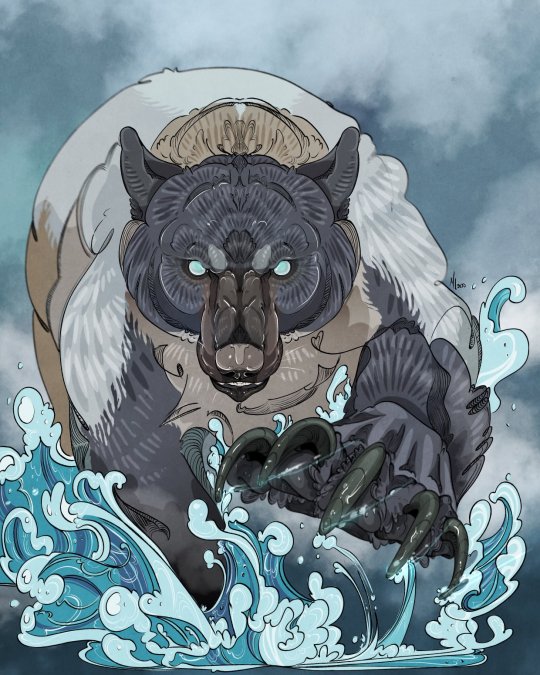

I'll be a tidal wave when I grow up
Crashing on harbours
I'll be a temperamental element
A raging water
#Glacier bear#Black bear#ursus americanus#Ursus americanus emmonsii#Charging#Water#Splashing#Stylized
487 notes
·
View notes
Photo

Glacier bear (Ursus americanus emmonsii)
Photo by Cathy and LaRhee
#glacier bear#american black bear#black bear#ursus americanus emmonsii#ursus americanus#ursus#ursinae#ursidae#arctoidea#caniformia#carnivora#carnivoramorpha#ferae#scrotifera#laurasiatheria#boreoeutheria#eutheria#mammalia#tetrapoda#vertebrata#chordata
1K notes
·
View notes
Photo
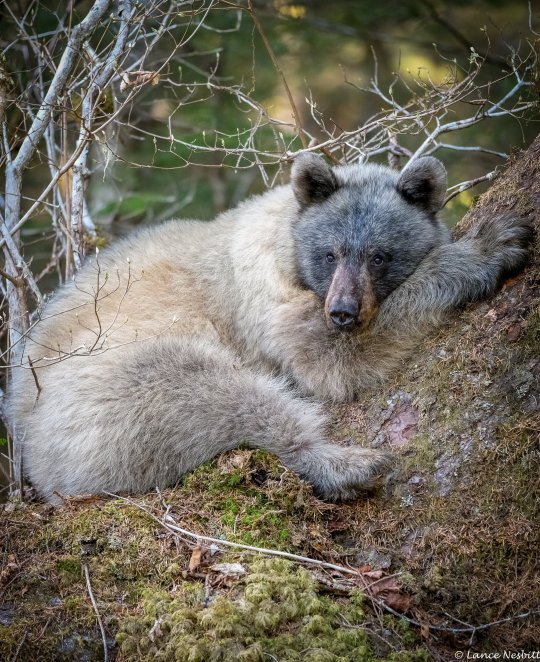
A glacier bear (Ursus americanus emmonsii) rests at the base of a tree in Alaska's Tongass National Forest in 2018.
Photograph by Lance Nesbitt
2K notes
·
View notes
Note
Hello :) Do you think colors of certain species have different meaning? I'm currently looking at black bears and their different coats, for example a normal black bear daemon vs a spirit bear daemon or glacier bear daemon. Any thoughts? Enjoying scrolling through your blog.
Hi!
So what's different about the bears you've listed compared to general color morphs is that these bears aren't just different colors than a usual blackbear, they're actually subspecies ( ursus americanus versus ursus americanus kermodei or ursus americanus emmonsii, in this case). So while I do think color variants matter, in this case the fact that they're a subspecies matters more! (In my opinion, anyway). One of the main things that sets these subspecies apart aside for the obvious aesthetics is that glacier and spirit bears tend to have very specific, limited ranges. Due to this, I would probably consider these subspecies to be less adaptable and more niche than regular blackbears.
Now, as there are very few spirit/glacier bears and they aren't well studied, the info we have about how they differ from regular blackbears behaviorally is limited. With subspecies like these, I wouldn't assume there would be many differences. So other than their habitat preferences, their coloring would take precedence. In general, I tend to think of coloring as a perception/perceived thing— it can be how others perceive you, or how you perceive yourself, it's up to you. This is also where symbolic differences come in. Spirit bears have a lot of mythological and cultural recognition, considering their prevalence in indigenous stories and later from books like Touching Spirit Bear (not one of my fav middle school books, gotta admit).
When it comes to specific color symbolism... spirit bears are white (ish), which has a lot of different meanings, depending on which culture you look at. I've seen it related to purity, wisdom, sterility, aloofness/coldness, power, vanity, traditionalism, spirituality... white kind of goes all over the place, which leaves a lot up to interpretation. I tend to look at local myths and legends to get a better sense of how color affects individual animal perceptions, which I think would be a good idea here.
Glacier bears are sort of difficult to talk about in regards to color meaning because they're frequently described as "blue", but they definitely aren't. They're not even really grey, which is a color that often symbolizes neutrality, moderation, humility, and indecisiveness. They're kinda siamese-looking, actually. But I think it's important that they're called blue, because that says a lot about how they're perceived. Blue is often related to depth, intelligence, royalty, passivity, sadness, and sometimes freedom. Blue is also considered somewhat mystical.
Both spirit bears and glacier bears get related to ghosts due to their rare and elusive natures. I would say that these bears are basically the same as regular black bear people, but they stand out, and either feel or are viewed as being different than their fellow black bears. I would think that spirit bears draw more attention, though whether they like it or not is debatable.
5 notes
·
View notes
Text
2p Kumajiro (2p Canada’s bear)
-I’d like to think 2p Kumajiro would be a Glacier Bear (Ursus americanus emmonsii).
-unlike his 1p counterpart 2p Kumajiro would be large, and ferocious.
-He will listen to 2p Canada and follow his orders.
-2p Kumajiro cannot talk.

#axis powers hetalia#hetalia#2p canada#2p#2p hetalia#aph#au#aph kumajirou#2p kumajirou#matt#headcannon
33 notes
·
View notes
Photo

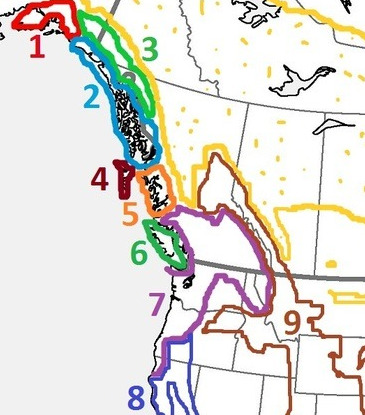
Updated my distribution range map for the 16 formally-recognized subspecies of American black bear (Ursus americanus).
Bad quality made with Working-Class GIS (M!cr*s*ft Paint).
Maybe pedantic. Because distribution ranges can be a mess. Like, here, some of the apparent “boundaries” between subspecies are probably inaccurate, ambiguous, fluctuating, etc. (For example: Is there really a subspecies-level distinction between the mainland PNW black bear and the Vancouver Island black bear? Does the cinnamon/Rocky Mountain black bear really live in such a narrow strip along the Continental Divide in the Canadian Rockies? Or, instead, is this region inhabited by multiple subspecies of black bear? Other subspecies, like the spirit bear, seem to have clearer and more distinct distribution ranges and habitats.)
Might be unsurprising, but I like how the biomass and ecological diversity of temperate rainforest (and the Pacific Northwest generally) has allowed for biodiversity of black bear (half of the total subspecies are also found along the coastal Pacific Northwest; half of the black bear’s total subspecies can be found within political borders of British Columbia, including the spirit bear of the Great Bear Rainforest, also known as Ursus americanus kermodei). And even within the region, the distribution limits of the Pacific Northwest subspecies correspond pretty well with ecological boundaries; like, within the political borders of Oregon alone, for example, the California black bear subspecies appropriately lives in Mediterranean-climate, California-style oak landscapes near Medford, while the "Pacific Northwest” subspecies occupies cedar-hemlock temperate rainforest of the Coast Range, and the “Rocky Mountain” subspecies lives in drier ponderosa forest and the Blue Mountains.
The distribution of the nominate subspecies - U.a. americanus - in the eastern U.S. is spotty and hard to accurately depict on range maps. The amount of urbanization, devegetation, and agriculture in the Midwest, Ohio River Valley, and Appalachia has pushed the bear out of permanent residency in many areas, though they still occasionally travel through much of the area east of the Mississippi. So, I added the outline of the historic (late 1800s) distribution of the black bear east of the Mississippi.
Here are the formally-recognized “common” names of each of the subspecies:
1. U.a. perniger: Kenai black bear
2. U.a. pugnax: Alexander Archipelago black bear
3. U.a. emmonsii: glacier bear
4. U.a. carlottae: Haida Gwaii bear
5. U.a. kermodei: Kermode bear or spirit bear
6. U.a. vancouveri: Vancouver Island black bear
7. U.a. altifrontalis: Olympic black bear or Pacific Northwest black bear
8. U.a. californiensis: California black bear
9. U.a. cinnamomum: cinnamon bear or “Rocky Mountain black bear”
10. U.a. amblyceps: New Mexico black bear
11. U.a. machetes: West Mexico black bear or Sierra Occidental black bear
12. U.a. eremicus: East Mexico black bear
13. U.a. luteolus: Louisiana black bear
14. U.a. floridanus: Florida black bear
15. U.a. hamiltoni: Newfoundland black bear
16. U.a. americanus: American black bear or eastern black bear


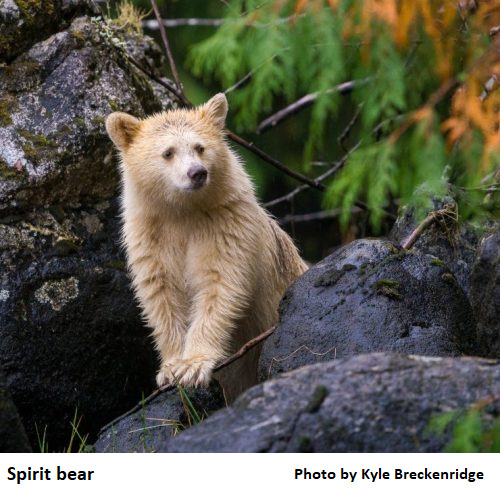
98 notes
·
View notes
Text
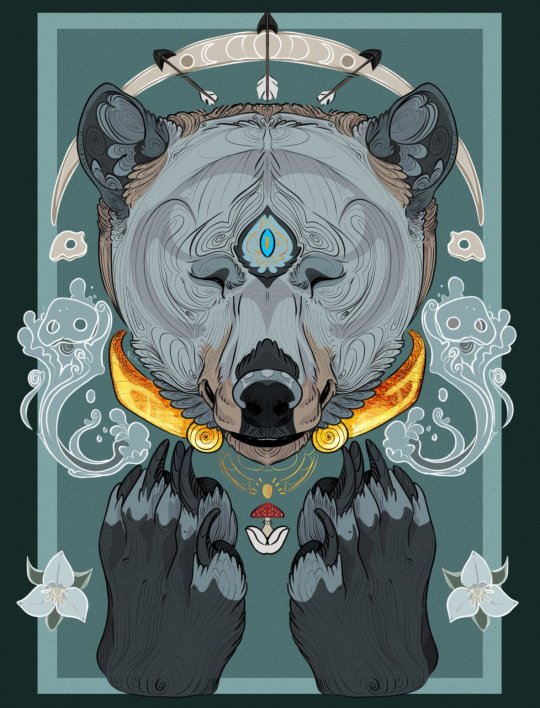
May Wishes.
#Glacier bear#Ursus americanus emmonsii#Trilium#Hag stones#Fairy stones#Witch#Waves#Lake#Ocean#Amanita muscaria#Sprout#Spring#Gold#Gilded#Wishful#Peaceful#Symbolism#Spiritual#Healing#Summoning
164 notes
·
View notes
Photo

Distribution range map for the 16 subspecies of American black bear
Got tired of not being able to find an adequate distribution map for the formally-recognized subspecies of American black bear (Ursus americanus). Unsurprisingly, the fertility, biomass, and ecological diversity of the Pacific Northwest has allowed for intense genetic diversity of black bear (half of the black bear’s subspecies can be found in the Pacific Northwest). For the curious, the “spirit bear” of the Great Bear Rainforest is known as Ursus americanus kermodei.
The distribution of the nominate subspecies - U.a. americanus - in the eastern U.S. is spotty and hard to accurately depict on range maps. The amount of urbanization, devegetation, and rural agriculture has pushed the bear out of permanent residency in many areas, though they still occasionally travel through much of the area east of the Mississippi.
Here are the formally-recognized “common” names of each of the subspecies:
1. U.a. perniger: Kenai black bear
2. U.a. pugnax: Alexander Archipelago black bear
3. U.a. emmonsii: glacier bear
4. U.a. carlottae: Haida Gwaii bear
5. U.a. kermodei: Kermode bear or spirit bear
6. U.a. vancouveri: Vancouver Island black bear
7. U.a. altifrontalis: Olympic black bear or Pacific Northwest black bear
8. U.a. californiensis: California black bear
9. U.a. amblyceps: New Mexico black bear
10. U.a. cinnamomum: cinnamon bear or “Rocky Mountain black bear”
11. U.a. machetes: West Mexico black bear or Sierra Occidental black bear
12. U.a. eremicus: East Mexico black bear
13. U.a. luteolus: Louisiana black bear
14. U.a. floridanus: Florida black bear
15. U.a. hamiltoni: Newfoundland black bear
16. U.a. americanus: American black bear or eastern black bear
Cinnamon bears - the primary subspecies of the Rocky Mountains - in Montana (Photo by National Parks Service):


-
Spirit bear in the Great Bear Rainforest of British Columbia (Photo 1 by Kyle Breckenridge; Photo 2 by Paul Nicklen for National Geographic):


-
Louisiana black bear, a species of the pine forests of the Gulf Coast 9Photo by US Fish and WIldlife):

7 notes
·
View notes